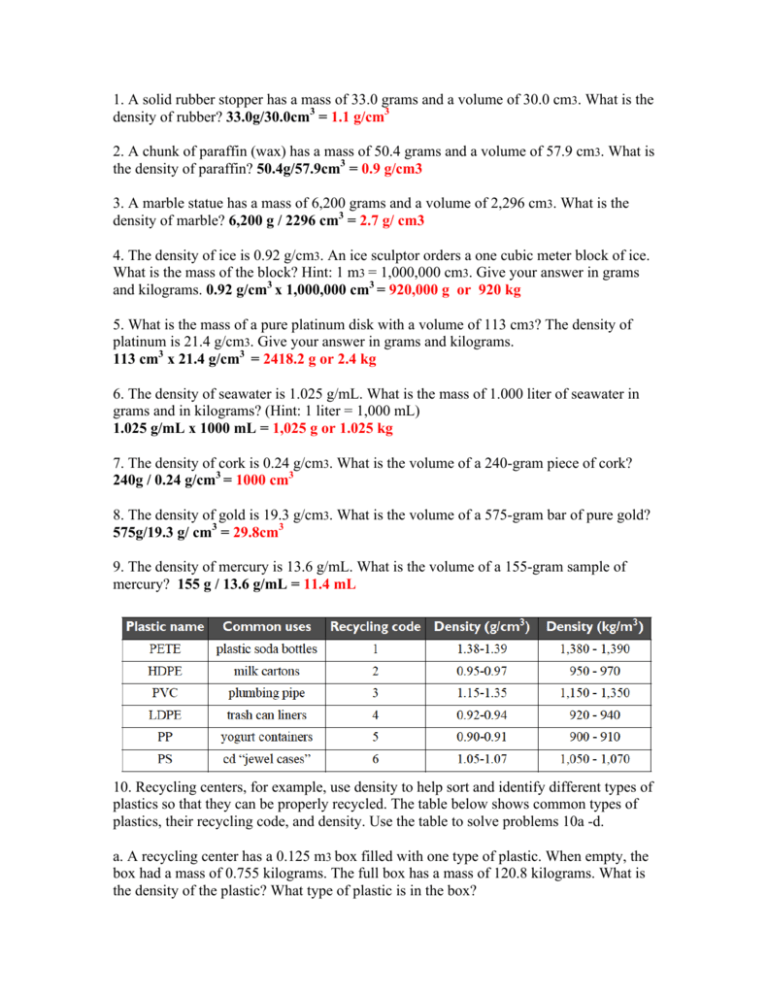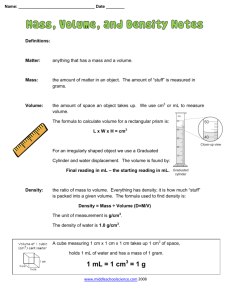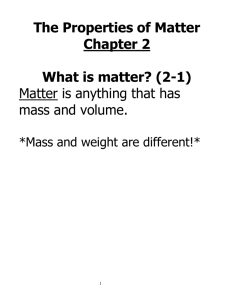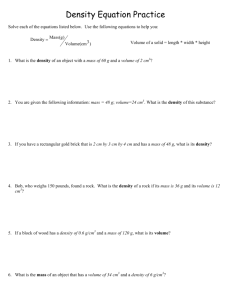1. A solid rubber stopper has a mass of 33.0 grams and a volume of
advertisement

1. A solid rubber stopper has a mass of 33.0 grams and a volume of 30.0 cm3. What is the density of rubber? 33.0g/30.0cm3 = 1.1 g/cm3 2. A chunk of paraffin (wax) has a mass of 50.4 grams and a volume of 57.9 cm3. What is the density of paraffin? 50.4g/57.9cm3 = 0.9 g/cm3 3. A marble statue has a mass of 6,200 grams and a volume of 2,296 cm3. What is the density of marble? 6,200 g / 2296 cm3 = 2.7 g/ cm3 4. The density of ice is 0.92 g/cm3. An ice sculptor orders a one cubic meter block of ice. What is the mass of the block? Hint: 1 m3 = 1,000,000 cm3. Give your answer in grams and kilograms. 0.92 g/cm3 x 1,000,000 cm3 = 920,000 g or 920 kg 5. What is the mass of a pure platinum disk with a volume of 113 cm3? The density of platinum is 21.4 g/cm3. Give your answer in grams and kilograms. 113 cm3 x 21.4 g/cm3 = 2418.2 g or 2.4 kg 6. The density of seawater is 1.025 g/mL. What is the mass of 1.000 liter of seawater in grams and in kilograms? (Hint: 1 liter = 1,000 mL) 1.025 g/mL x 1000 mL = 1,025 g or 1.025 kg 7. The density of cork is 0.24 g/cm3. What is the volume of a 240-gram piece of cork? 240g / 0.24 g/cm3 = 1000 cm3 8. The density of gold is 19.3 g/cm3. What is the volume of a 575-gram bar of pure gold? 575g/19.3 g/ cm3 = 29.8cm3 9. The density of mercury is 13.6 g/mL. What is the volume of a 155-gram sample of mercury? 155 g / 13.6 g/mL = 11.4 mL 10. Recycling centers, for example, use density to help sort and identify different types of plastics so that they can be properly recycled. The table below shows common types of plastics, their recycling code, and density. Use the table to solve problems 10a -d. a. A recycling center has a 0.125 m3 box filled with one type of plastic. When empty, the box had a mass of 0.755 kilograms. The full box has a mass of 120.8 kilograms. What is the density of the plastic? What type of plastic is in the box? Mass = 120.8 kg – 0.755 kg = 120.045 kg / 0.125 m3 = 960.36 kg/m3 HDPE b. A truckload of plastic soda bottles was finely shredded at a recycling center. The plastic shreds were placed into 55-liter drums. What is the mass of the plastic shreds inside one of the drums? Hint: 55 liters = 55,000 milliliters = 55,000 cm3. 1.38 g/cm3 x 55,000 cm3 = 75,900 g 1.39 g/cm3 x 55,000 cm3 = 76,450 g range 75,900 g – 76,450 g c. A recycling center has 100 kilograms of shredded plastic yogurt containers. What volume is needed to hold this amount of shredded plastic? How many 10-liter (10,000 mL) containers do they need to hold all of this plastic? Hint: 1 m3 = 1,000,000 mL. 100 kg/900 kg/m3 = 0.11 m3 100 kg/910 kg/m3 = 0.11 m3 0.11 m 3 x 1,000,000 = 110,000 mL 110,000 mL / 10,000 mL (containers) = 11 containers d. A solid will float in a liquid if it is less dense than the liquid, and sink if it is more dense than the liquid. If the density of sea water is 1.025 g/mL, which types of plastics would definitely float on sea water? HDPE, LDPE, PP






